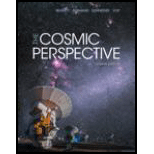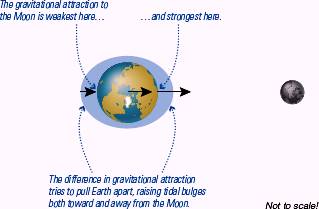
The given figure shows how the Moon causes tides on Earth. Note that the North Pole is in the center of the diagram, so the numbers 1 through 4 label points along Earth’s equator.
What do the three black arrows represent?
A. The tidal force Earth exerts on the Moon.
B. The Moon’s gravitational force at different points on Earth.
C. The direction in which Earth’s water is flowing
D. Earth’s orbital motion
Answer to Problem 1VSC
Solution:
The attraction is Minimum at point 3 which feels least gravitational attraction. Hence option (B) is correct. Since in figure gravitational pull of the Moon on Earth which gives rise to tides and the North Pole is at the center in this diagram and the numbered points are along the circumference of the equator. The black arrows represent the gravitational pull of the Moon on the Earth. The length of arrows denotes the strength of attraction. The arrow is longest at point 1, which is closest to the moon denoting that the attraction is Maximum there.
Explanation of Solution
Introduction:
Visual information used in astronomy shows how the Moon causes tides on Earth. Here in diagram North Pole is in the center of the diagram, so the numbers 1 through 4 label points along Earth’s equator.

In the figure, Tides are created by the difference in the force of attraction between the Moon and different parts of Earth. The two daily high tides occur as a location on Earth rotates through the two tidal bulges. (The diagram greatly exaggerates the tidal bulges, which raise the oceans only about 2 meters and the land only about a centimeter.)
The figure shown above shows the gravitational pull of the Moon on Earth which is responsible for giving rise to tides. At the center in this diagram the North Pole is found and along the circumference of the equator, the numbered points are there. The gravitational pull of the Moon on the Earth is represented by the black arrows. The strength of attraction is denoted by the length of arrows. The arrow is longest at point 1 and that is closest to the moon clearly denoting that the attraction is shown Maximum there. The attraction is Minimum at point 3 and thus feels least gravitational attraction. Hence option (B) is correct. The force exerted by the Moon on Earth denoted by the black arrows. Tidal force can be defined as the “stretching force which acts on a body due to the difference in gravitational attraction on its two opposite ends. Therefore, option (a) is clearly not correct.
The arrows are not denoting the direction flow of water. Hence, option (C) mentioned is also not correct. The black arrows are pointing in the direction of the moon. The orbital motion of Earth is also clearly not towards the Moon. Hence, option (D) is not correct.
Conclusion:
The gravitational pull of the Moon on Earth which gives rise to tides. The black arrows representing the gravitational pull of the Moon on the Earth and length of arrows denotes the strength of attraction. Tidal force is defined as the stretching force that acts on a body due to the difference in gravitational attraction on its two opposite ends.
Want to see more full solutions like this?
Chapter 4 Solutions
The Cosmic Perspective (8th Edition)
- What are the expected readings of the ammeter and voltmeter for the circuit in the figure below? (R = 5.60 Ω, ΔV = 6.30 V) ammeter I =arrow_forwardsimple diagram to illustrate the setup for each law- coulombs law and biot savart lawarrow_forwardA circular coil with 100 turns and a radius of 0.05 m is placed in a magnetic field that changes at auniform rate from 0.2 T to 0.8 T in 0.1 seconds. The plane of the coil is perpendicular to the field.• Calculate the induced electric field in the coil.• Calculate the current density in the coil given its conductivity σ.arrow_forward
- An L-C circuit has an inductance of 0.410 H and a capacitance of 0.250 nF . During the current oscillations, the maximum current in the inductor is 1.80 A . What is the maximum energy Emax stored in the capacitor at any time during the current oscillations? How many times per second does the capacitor contain the amount of energy found in part A? Please show all steps.arrow_forwardA long, straight wire carries a current of 10 A along what we’ll define to the be x-axis. A square loopin the x-y plane with side length 0.1 m is placed near the wire such that its closest side is parallel tothe wire and 0.05 m away.• Calculate the magnetic flux through the loop using Ampere’s law.arrow_forwardDescribe the motion of a charged particle entering a uniform magnetic field at an angle to the fieldlines. Include a diagram showing the velocity vector, magnetic field lines, and the path of the particle.arrow_forward
- Discuss the differences between the Biot-Savart law and Coulomb’s law in terms of their applicationsand the physical quantities they describe.arrow_forwardExplain why Ampere’s law can be used to find the magnetic field inside a solenoid but not outside.arrow_forward3. An Atwood machine consists of two masses, mA and m B, which are connected by an inelastic cord of negligible mass that passes over a pulley. If the pulley has radius RO and moment of inertia I about its axle, determine the acceleration of the masses mA and m B, and compare to the situation where the moment of inertia of the pulley is ignored. Ignore friction at the axle O. Use angular momentum and torque in this solutionarrow_forward
- A 0.850-m-long metal bar is pulled to the right at a steady 5.0 m/s perpendicular to a uniform, 0.650-T magnetic field. The bar rides on parallel metal rails connected through a 25-Ω, resistor (Figure 1), so the apparatus makes a complete circuit. Ignore the resistance of the bar and the rails. Please explain how to find the direction of the induced current.arrow_forwardFor each of the actions depicted, determine the direction (right, left, or zero) of the current induced to flow through the resistor in the circuit containing the secondary coil. The coils are wrapped around a plastic core. Immediately after the switch is closed, as shown in the figure, (Figure 1) in which direction does the current flow through the resistor? If the switch is then opened, as shown in the figure, in which direction does the current flow through the resistor? I have the answers to the question, but would like to understand the logic behind the answers. Please show steps.arrow_forwardWhen violet light of wavelength 415 nm falls on a single slit, it creates a central diffraction peak that is 8.60 cm wide on a screen that is 2.80 m away. Part A How wide is the slit? ΟΙ ΑΣΦ ? D= 2.7.10-8 Submit Previous Answers Request Answer × Incorrect; Try Again; 8 attempts remaining marrow_forward
 College PhysicsPhysicsISBN:9781305952300Author:Raymond A. Serway, Chris VuillePublisher:Cengage Learning
College PhysicsPhysicsISBN:9781305952300Author:Raymond A. Serway, Chris VuillePublisher:Cengage Learning University Physics (14th Edition)PhysicsISBN:9780133969290Author:Hugh D. Young, Roger A. FreedmanPublisher:PEARSON
University Physics (14th Edition)PhysicsISBN:9780133969290Author:Hugh D. Young, Roger A. FreedmanPublisher:PEARSON Introduction To Quantum MechanicsPhysicsISBN:9781107189638Author:Griffiths, David J., Schroeter, Darrell F.Publisher:Cambridge University Press
Introduction To Quantum MechanicsPhysicsISBN:9781107189638Author:Griffiths, David J., Schroeter, Darrell F.Publisher:Cambridge University Press Physics for Scientists and EngineersPhysicsISBN:9781337553278Author:Raymond A. Serway, John W. JewettPublisher:Cengage Learning
Physics for Scientists and EngineersPhysicsISBN:9781337553278Author:Raymond A. Serway, John W. JewettPublisher:Cengage Learning Lecture- Tutorials for Introductory AstronomyPhysicsISBN:9780321820464Author:Edward E. Prather, Tim P. Slater, Jeff P. Adams, Gina BrissendenPublisher:Addison-Wesley
Lecture- Tutorials for Introductory AstronomyPhysicsISBN:9780321820464Author:Edward E. Prather, Tim P. Slater, Jeff P. Adams, Gina BrissendenPublisher:Addison-Wesley College Physics: A Strategic Approach (4th Editio...PhysicsISBN:9780134609034Author:Randall D. Knight (Professor Emeritus), Brian Jones, Stuart FieldPublisher:PEARSON
College Physics: A Strategic Approach (4th Editio...PhysicsISBN:9780134609034Author:Randall D. Knight (Professor Emeritus), Brian Jones, Stuart FieldPublisher:PEARSON





